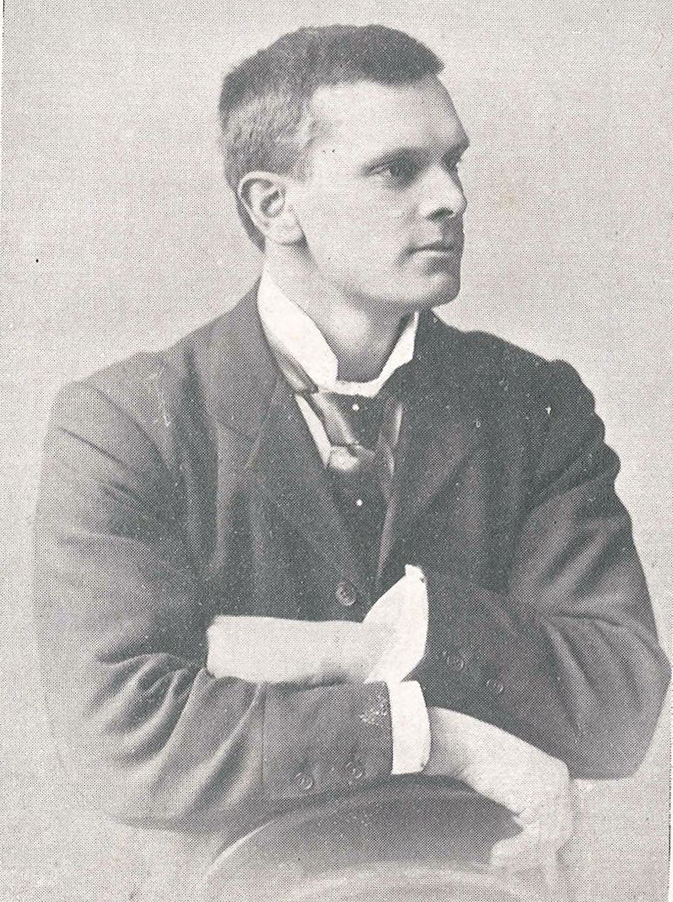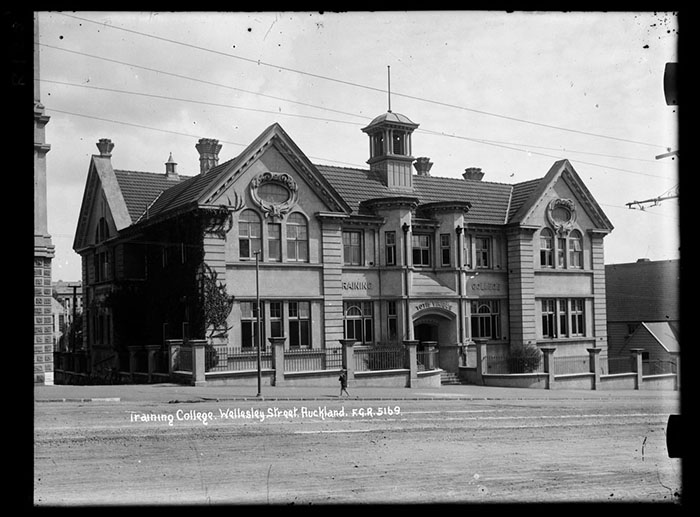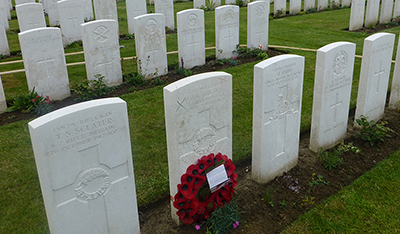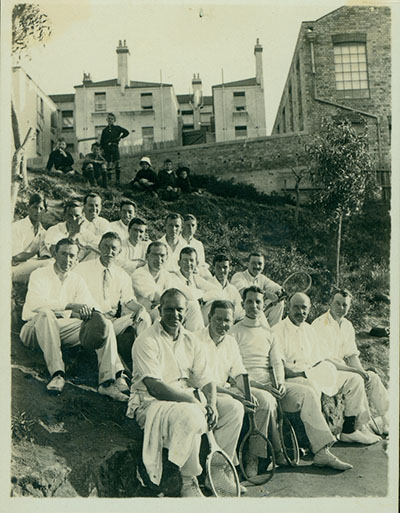
Players in an Auckland University College vs Training College tennis match, ca. 1914. At least seven of the men served in the War, five returned. Herbert Milnes is front left. University of Auckland Historical collection: part one. MSS & Archives E-8, box 7, folder 2. Special Collections, University of Auckland Libraries and Learning Services.
Herbert Milnes
It is unsurprising that Herbert Milnes volunteered to serve in the War at the age of 41. A charismatic man and a natural leader, he was ideally suited for his eventual post as Second Lieutenant in an Auckland Infantry battalion.
Herbert Albert Edwin Milnes was principal of the Auckland Training College and education lecturer at Auckland University College from 1906-1916.1 The Training College and University College enjoyed close links, with students often taking university papers while completing their teacher training. Of the five men specified as University staff in the Roll of Honour, Milnes was the only one to die, killed in action a few months after arriving at the Western Front.
Born in Leeds in 1874, Milnes was appointed principal of the newly re-established Auckland Training College in November 1905.2 He arrived from Isleworth, Middlesex, in February 1906 to find that he had the task of building a teachers’ college essentially from scratch. He was undaunted and immediately set about building a vibrant institution over his decade as principal.3 Milnes was a tireless advocate of the popular early-twentieth-century ideology of athleticism, and a focus on physical health permeated every aspect of his life and work. His warmth and charisma, and his belief in the close links between manliness, militarism, and civic duty made him an ideal candidate for serving as a commissioned officer.4
Before his arrival in New Zealand in 1905, Milnes had worked as a house tutor at Borough Road College, where he achieved his degree through sheer perseverance after failing multiple times.5 He was renowned around that college for his health, athleticism, love of cold showers, and his belief in the toughening powers of light bedclothes.6 Milnes had reluctantly tendered his resignation from Borough Road College — an institution that he loved — but he hoped that the climate in New Zealand would be better for his seriously ill fiancée Louisa.7 Milnes and Louisa were married in New Zealand in late 1906.8
Over the next decade, Milnes applied himself to establishing a teachers’ college based on his preference for well-rounded students rather than bookish types.9 He relished the freedom he had in New Zealand, and was delighted to be ‘free from the cast-iron rules and regulations that are so harassing in England’.10 Under his leadership, the atmosphere of the Training College became exceptionally collegial, and due to his zeal for athleticism, physical culture and sport became integral aspects of college life.11 His main concern for his students and their eventual pupils was their health and happiness rather than the accumulation of facts.12
He insisted on bright and inviting classrooms, and when declined a grant for pictures, a college custom arose in which departing students would contribute half-a-crown towards a fund for pictures for the walls.13 The Training College, on Wellesley Street, developed a thriving social life, with eagerly anticipated socials on alternate Saturday nights and an annual picnic excursion to places like Motutapu Island and Manukau Heads. Milnes founded the ‘Old A’s’ — a network of alumni modelled on the ‘Old B’s’ of Borough Road College — and this network became so close-knit that a group of 24 past students held a reunion in France in 1918, just six miles behind the front line.14
Milnes encouraged all students to learn swimming, lifesaving, and first aid, and for all men to train in rifle shooting. He personally supervised physical education, nurtured an involvement in games like fives and tennis, and was an early exponent of basketball in New Zealand. During the early years of the Training College, there were not enough male students to form a rugby team, so close sporting ties developed with the University College.15 True to form, Milnes played front row for the University College XV.16
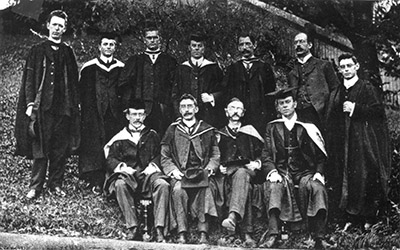
Auckland University College professors and lecturers, 1907. Herbert Milnes is in the back row, third left. University of Auckland History Series. MSS & Archives 97/5, 6.1.2.1c. Special Collections, University of Auckland Libraries and Learning Services.
War service
Milnes, whose wife Louisa had died in 1913, enlisted on 7 March 191617 and was soon promoted to second lieutenant. His physical energy, strength of character, and enthusiasm for games meant that he rapidly won the affection of his men, just as he had at Borough Road and in Auckland.18 He had proposed that he lead a battalion of educationalists which, perhaps fortunately, never eventuated.19 Milnes embarked for Plymouth on 21 January 1917 and trained at Salisbury Plain.20 He was deployed to the Western Front with the Auckland Infantry on 29 May 1917. Milnes was killed instantly at Passchendaele, Belgium on 4 October 1917 when a shell landed almost at his feet as he led the 3rd Company of the 3rd Auckland Battalion in an assault on a pill box known as Otto Farm.21
Milnes’s death had a profound effect on the numerous people he had crossed paths with in Auckland and Borough Road.22 The news of his death reached the Training College at 3pm on Friday 12 October, and was announced to students assembled in the hall; the College was closed in his honour until the following Tuesday.23 Milnes’s untimely death cemented his almost mythical status at the Training College, and he proved difficult to replace. A brass tablet in his memory was unveiled in the College hall on 25 September 1918, and a memorial service was held every year on the anniversary of his death during the term of the subsequent principal. A bronze memorial commemorating the 31 fallen ‘Old A’s’ — including Milnes — was unveiled in the Library at the College’s new Epsom campus on 1 September 1926.24
Jonathan Burgess, Special Collections
- Calendar, Auckland University College, University of New Zealand, 1914, p.v.
- ‘Herbert Albert Edwin Milnes’, Cenotaph Database, Auckland War Memorial Museum, accessed June 20 2014; Louise Shaw, Making a Difference: A History of the Auckland College of Education 1881-–2004, Auckland, 2006, p.34; Wanganui Herald, 1 November 1905, p.7, accessed via Papers Past.
- Shaw, p.35; J.A. Mangan and Colm Hickey, ‘A Pioneer of the Proletariat: Herbert Milnes and the Games Cult in New Zealand’, International Journal of the History of Sport, 17, 2–3, 2000, p.38.
- Shaw, p.43; Mangan and Hickey, p.44.
- Mangan and Hickey, pp.33–38.
- ibid., p.36.
- ibid., p.38.
- ‘Milnes, Herbert Albert Edwin – WW1 22525 - Army [Original Paper Personnel File]’, R7880527, Archives New Zealand, Wellington.
- Shaw, p.42.
- ibid., p.37.
- ibid., pp.42–43.
- ibid., p.44.
- ibid., p.35.
- ibid., pp.53–56.
- ibid., pp.43–46.
- Mangan and Hickey, p.41.
- ‘Milnes, Louisa Heath’, Waikumete Cemetery, Auckland Council Cemeteries Database, accessed 23 June 2014; ‘Herbert Albert Edwin Milnes’.
- Mangan and Hickey, p.43.
- Shaw, p.43.
- ‘Herbert Albert Edwin Milnes’.
- Peter Cooke, John H. Gray, and Ken Stead, Auckland Infantry, Auckland, 2010, pp.167–168; New Zealand Herald, 15 October 1917, p.1; ‘Herbert Albert Edwin Milnes’; O.E. Burton, The Auckland Regiment, Auckland, 1922, pp.174–5.
- Mangan and Hickey, p.43.
- Shaw, p.56.
- ibid., p.57; Auckland Star, 1 September 1926, p.6.



